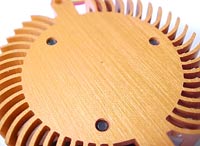| Test System
Specs: |
| Test System: |
AMD Athlon (Tbird) 700Mhz @ 878Mhz (7.5 x 117)
MSI K7T-Turbo
256MB Apacer ram
MSI Starforce 817 Geforce2 MX
SB Live! Value
Generic full tower case w. lotsa fans, hard drives, burner, etc. |
| Cooling: |
Arctic silver II thermal
paste |
Test procedure
I decided to test the orange orb against the
older blue orb as well as the passive cooling that came stock on
my MSI Geforce 2 MX card. To test the cooling abilities of the heatsinks,
I ran each setup through 2 tests twice. Once at standard (175/166) core
and memory settings, and again at the highest stable clock
settings I had been able to achieve with the passive cooling setup, 215(core)/194(mem).
To test the average 'idle' temperature of the card, I left my
system sitting at desktop with explorer open for 1 hour (monitor shutdown and
screen saver disabled). To test the temperature of the card during actual
gaming, I ran 3dmark 2001 through 10 loops of the first three game tests,
approximately 30 minutes long, and recorded the highest temperature reached. All
temperatures were recorded with a thermistor taped to the back of the card over
the core.
| Heatsink |
Idle(175/166) |
Load (175/166) |
Idle (215/194) |
Load (215/194) |
| Passive Heatsink |
42 C |
46 C |
45 C |
49 C |
| Orange Orb |
40 C |
43 C |
42 C |
45 C |
| Blue Orb |
40 C |
44 C |
43 C |
46 C |
Hmm... I guess I was hoping for a little bit more of a temperature
differential between the various setups. Then again, the two orbs certainly
make a noticeable difference over the passive sink. If this was my CPU cooling
setup, I'd be pretty pleased with a 4C drop...
The Orange orb is the overall winner, pulling ahead of the Blue
orb by a degree in 3 of the four tests. It was also (unsurprisingly) able to
reach the highest stable core clock I have managed to get out of this card,
228Mhz. The Blue orb fell off after 224, and the stock heatsink could only do
215 stable as I had mentioned. For this review, I am defining 'stable' as finishing
the load benchmark (10 loops of each of the first 6 tests) successfully with
no visible artifacts. My 3dmark scores I am not going to publicize, to avoid
being mocked by Colin, but if you are curious, let me know. :)

I was a little surprised with the results from the Blue orb, I was
honestly expecting it to be a more efficient heatsink than the Orange Orb, but
I guess that the full contact base and one piece design are more important than
sheer surface area and fan speed... I even cleaned off the thermal paste and
re-applied just in case I'd put too much on when I attached the Blorb, but same
results. I'd like to do this again with an Asus card with built in temperature
measurement sometime soon.
Overall, I can recommend the Orange orb to anyone who is currently using a
passive heatsink on their video card (provided you make sure the clips stay clear
of the fan). For replacing stock active heatsinks on newer cards like the
Geforce3, I have my doubts that it is going to make much of a difference. I will
test this as soon as I get the chance, but please let me know if you have already
tried it. If you already have a Blue orb and you really want to use your
first PCI slot, consider this BGA heatsink a must buy.
